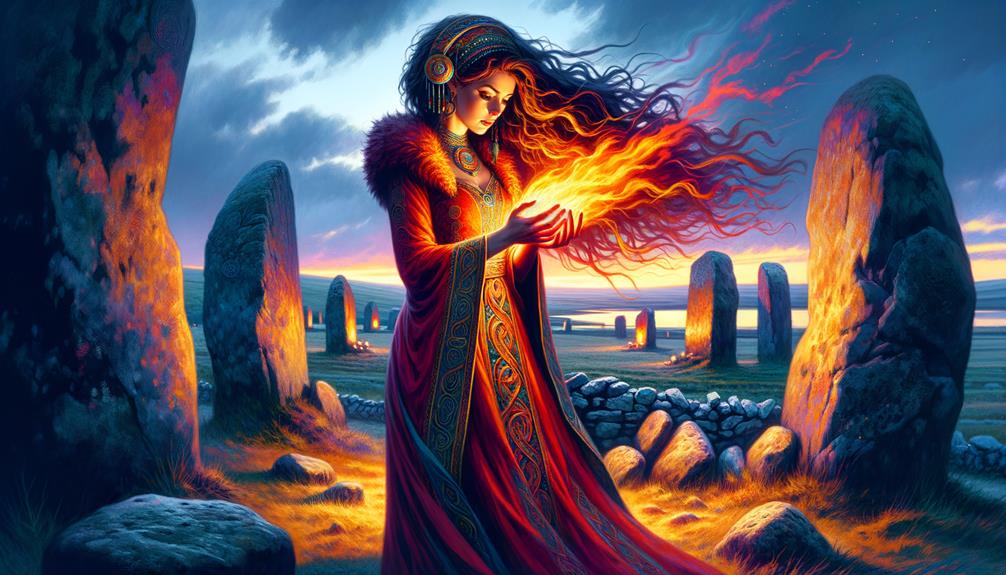When it comes to the intriguing world of Celtic mythology, Brigid really stands out. She's known as a fire goddess, but she's so much more than that. Picture a symbol of change, someone who nurtures and shares wisdom, who unites the unlikely duo of fire and water in her being. Brigid isn't just about fire and transformation, though. She's also deeply connected to healing, the art of poetry, and the craft of metalsmithing, which adds some serious cultural depth to her story.
What's more, she's not just a deity of the great outdoors or the ethereal world. Her story is grounded in the everyday life of the Celts. The yearly festival of Imbolc, for example, highlights her connection to fertility and her importance in the home. To put it simply, she was a big deal in the domestic life of the Celts.
But there's so much more to Brigid's story. Her influence stretches from ancient times right up to the present, with modern neo-pagan practices still honouring her. So, if you're interested in mythology, history or spirituality, Brigid's story is definitely one to check out.
The Myth and History of Brigid
Check out the story of Brigid, a widely admired goddess from pan-European mythology. She's got a rich past that's all about healing, fire, and poetry. Known as the goddess of the home, she stands for unity, hospitality, and that nurturing instinct found in all women.
What's really cool about Brigid is her ability to balance fire and water – it's the perfect example of harmony. Plus, her connection to fertility highlights her ties with nature and the importance of maintaining a balanced ecosystem.
Every spring, there's this festival called Imbolc where Brigid is celebrated. It's all about generosity and the rebirth of life. She's seen as the protector of the home and a champion of healing practices, emphasizing the value of caring and safeguarding in her story.
Brigid's lasting influence is a testament to the diverse aspects of female strength and wisdom. So, there you have it – the tale of Brigid, a splendid goddess with a fascinating past.
Brigids Role in Celtic Culture
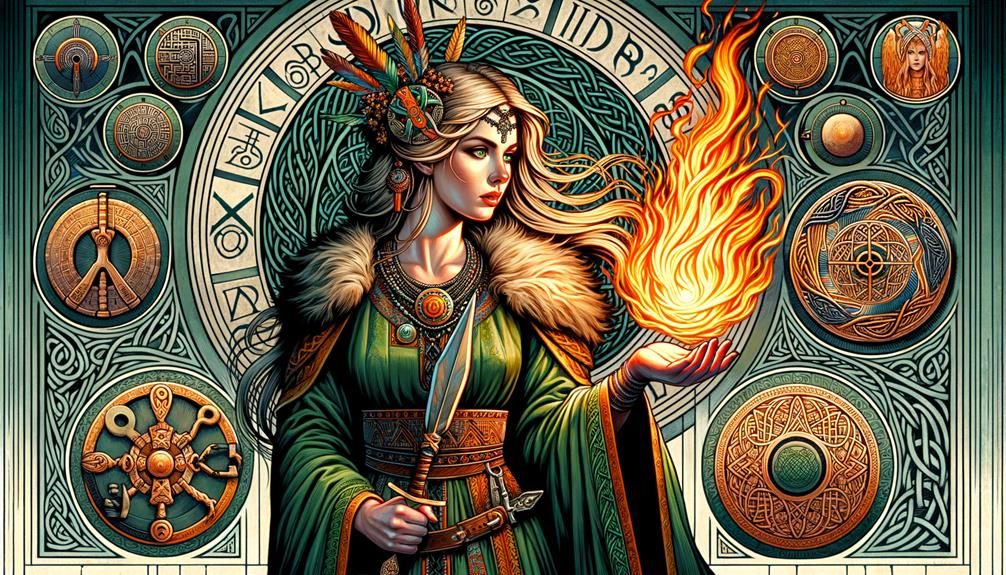
Brigid held an essential place in Celtic culture, as a revered goddess associated with healing, poetry, and blacksmithing. Known as Ireland's Flame, she was a source of light, creative inspiration, and safeguarding. She was also considered the heart of the domestic setting, the sacred fire that kept Celtic homes cozy and secure.
- Brigid, in her capacity as a Celtic goddess, was deeply respected for her connection with elements like fire, water, and fertility.
- Her ties to sacred wells highlighted her role as a goddess of healing and purification.
- The festival of Imbolc, or Brigid's Day, honoured her as Brigid of Kildare and signified the start of spring and the rejuvenation of life.
Brigid's impact was truly significant, reaching every aspect of Celtic life, from daily tasks to hallowed ceremonies.
Sacred Rituals and Festivals
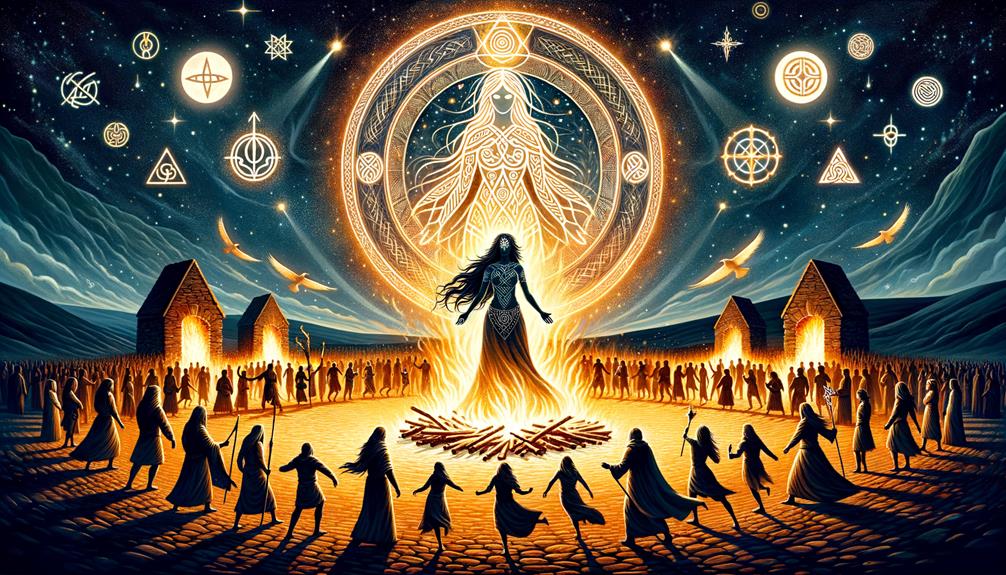
Brigid had a big role in the regular lives of the Celts, but this was especially true during their sacred rituals and festivals. One such festival, Imbolc, which was celebrated on the first day of February, signaled the start of spring. It was a moment for rejuvenation and fertility. As both a saint and a goddess, Brigid was deeply respected for her connection with the end of winter and the rebirth of life.
Let's take a look at some of the rituals that were performed in honor of Goddess Brigid during Imbolc:
| Ritual | Purpose | Symbolism |
|---|---|---|
| Making Brigid's Crosses | A tribute to Brigid | Fertility, protection |
| Inviting Brigid into the house | A signal of spring's arrival | Renewal, fresh starts |
| Eating corn cakes | A harvest celebration | Plenty, provision |
| Singing sacred songs | A call for Brigid's blessings | Spiritual bonding |
| Honoring maidens | Recognition of Brigid's virgin aspect | Innocence, purity |
These practices truly captured the spirit of Brigid, blending Christian and pagan beliefs in a special way to welcome the spring season.
Brigid in Modern Neo-Paganism
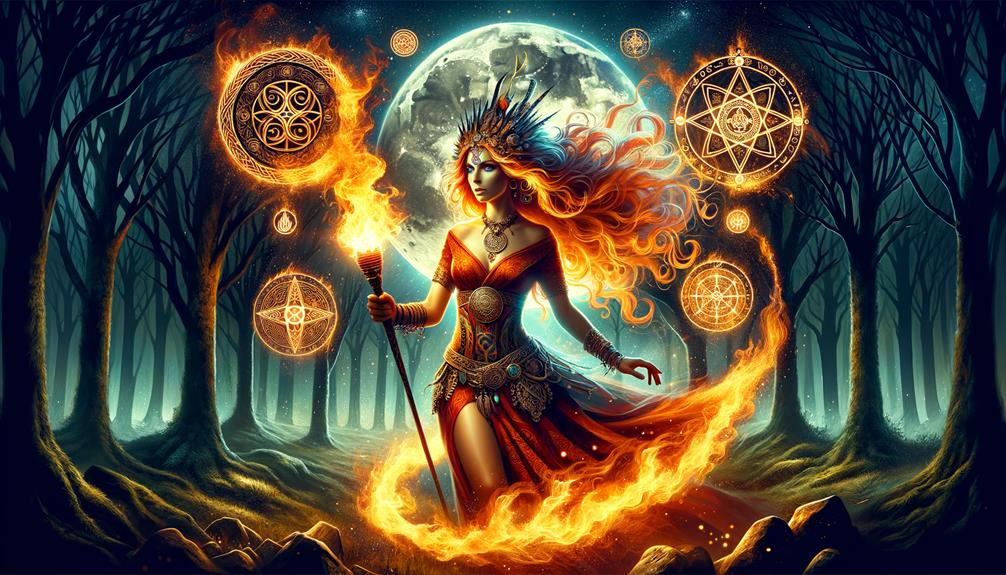
Brigid, the Celtic Fire Goddess, is still a big deal in today's Neo-Paganism, and it's easy to see why. She's a triple threat, known for her healing powers, her poetic prowess, and her smithing skills. Modern Neo-Pagans find her a fascinating figure, and she's a key player in their spiritual practices.
Here's what makes Brigid so special to them:
- Her name literally means 'high one,' which links her to ancient deities like the British goddess Brigantia and Indo-European dawn goddesses. It's a reminder of her deep ties to ancient myths.
- Her three key traits: healing, poetry, and smithing, make her a central figure in spiritual practices. It's not every day you find a deity that embodies all three.
- She's such a big deal that some pagans worship her alongside other major deities like Lugh or Cernunnos. That's a significant endorsement of her standing in the pantheon.
In short, Brigid's lasting appeal is a testament to the blend of old and new in modern Neo-Paganism. It's a fascinating mix that keeps the tradition alive and vibrant.
The Symbolism of Fire in Brigids Mythology
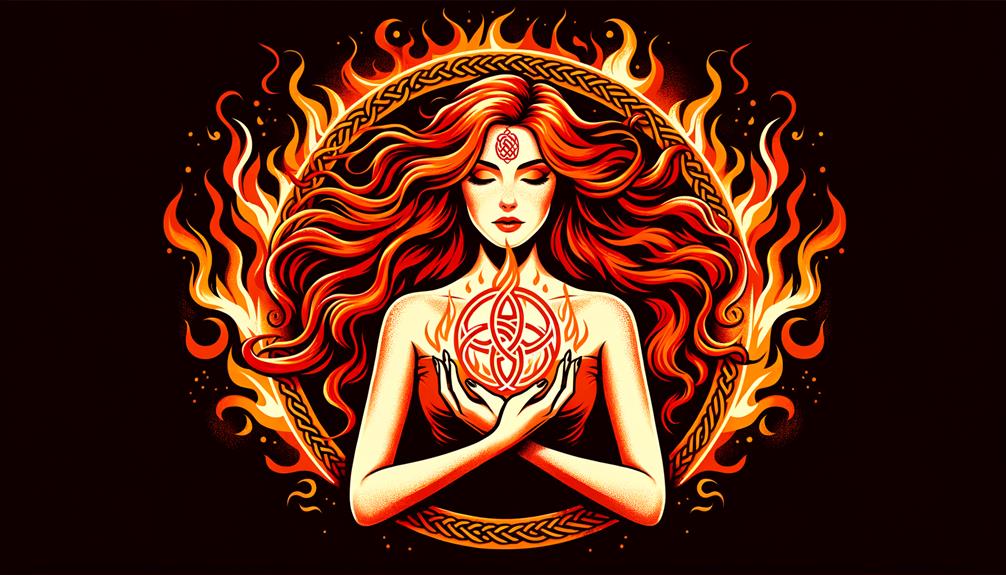
In the tales of Brigid, fire plays a critical role, carrying deep symbolism. It's a symbol of change, a spark of inspiration, and a sign of new beginnings. Fire sits at the heart of Brigid's stories, mirroring creativity, zeal, and the vital spark of existence.
Consider the sacred flame of Kildare, for instance. It's strongly associated with Brigid and carries meanings of safeguarding, healing, and a sense of the divine. Brigid's fire also stands for the comfort of welcome, the illumination of wisdom, and the cleansing power of purification. As a symbol, fire has a dual character, representing both ruin and creation in Brigid's tales. This duality underscores the equilibrium of these aspects.
Here's a rundown of the symbols and their meanings:
- Transformation: The changing power of fire
- Inspiration: The creative spark
- Renewal: The concept of rebirth and regeneration
- Sacred Flame: The ideas of protection, healing, and a divine presence.
Frequently Asked Questions
Who Is the Celtic Goddess of Flame?
Let's have a chat about this. The Celtic goddess of flame is indeed a fascinating figure. She's often seen as a symbol of inspiration and light, much like the sun's powerful energy. People hold her in high regard because of her healing abilities, and she's known to guide individuals through life's changes with her fiery might.
What Does the Goddess Brigid Symbolize?
You know, Brigid is quite an interesting figure. She's all about fire and inspiration, and she really embodies creativity. But that's not all there is to her. She also symbolizes balance, which is really fascinating. Think about it: light and dark, creation and destruction. It's all about harmonizing opposites. She's also about healing and protection, which goes hand in hand with her association with fire. Fire, after all, can be both destructive and transformative. And of course, we can't forget that Brigid is seen as a flame of hope, always burning and signifying renewal. Isn't that something?
Is Brigid the Daughter of the Morrigan?
Actually, in Celtic mythology, Brigid isn't considered the Morrigan's offspring. They stand as individual goddesses, each with their own unique duties. For instance, Brigid is linked with aspects of healing and the arts, while Morrigan signifies areas such as conflict, destiny, and governance.
What Is the Color Associated With Brigid?
You know, when we talk about Brigid, a fiery and vivid red comes to mind. It's a color that's as intense as a sunset on a hot summer's evening. This color is not just a random choice, it's deeply symbolic. It represents her fiery passion, her boundless creativity, and her life-giving energy. Think about how it feels when winter finally gives way to spring, that's the kind of transformation we're talking about. This red is a powerful reminder of Brigid's transformative energy, shifting us from the cold of winter into the welcoming warmth of spring.

